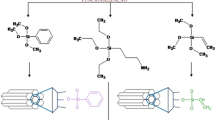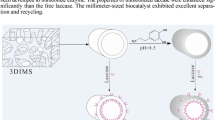Abstract
In this work, we report the synthesis and application of polymeric macroporous materials functionalized with ionic liquid (IL)-like moieties to serve as a support for enzyme immobilization. The method was based on bottom-up approach, where poly(styrene–divinylbenzene) (PS–DVB) nanoparticles were used as building blocks to form porous structures. Surface functionalization was done by introducing 1-butyl imidazole into the PS–DVB support to form IL-like imidazolium, which was consequently used for enzyme adsorption immobilization on the porous surface. To demonstrate activity of immobilized enzyme, hydrolysis of urea catalyzed by Jack bean urease was used as a model reaction. The enzymatic activity of the urease to convert urea solution into carbon dioxide (hydrocarbonates in water solution) and ammonia under acidic conditions were monitored both by measuring changes in pH and by a color change in cresol red pH indicator. The immobilized urease was able to provide hydrolysis of urea solution for 30 days while maintaining its activity over 100% compared to free enzyme solution. The activity of freshly immobilized enzyme was increased up to 285% compared to free urease solution under acidic conditions, which is caused by an acidic shift of activity–pH bell-shaped curve. Prepared porous material with immobilized urease was able to undergo four consequent cycles over the period of 4 days with only 15% decrease in activity. Overall, the results indicated that the polymeric support is well suitable to combine the advantages of macroporous material with IL-like surface moieties for enzyme immobilization and its consequent application in bio-catalytic reactions.






Similar content being viewed by others
References
Hentze H-P, Antonietti M (2008) Porous polymers and resins. Wiley-VCH Verlag GmbH, Weinheim
Okay O (2000) Macroporous copolymer networks. Prog Polym Sci 25:711–779
Sherrington DC (1998) Preparation, structure and morphology of polymer supports. Chem Commun 21:2275–2286
Lv Y, Lin Z, Tan T, Svec F (2014) Preparation of reusable bioreactors using reversible immobilization of enzyme on monolithic porous polymer support with attached gold nanoparticles. Biotechnol Bioeng 111:50–58
Urban J, Svec F, Fréchet JMJ (2012) A monolithic lipase reactor for biodiesel production by transesterification of triacylglycerides into fatty acid methyl esters. Biotechnol Bioeng 109:371–380
Izquierdo DF, Yates M, Lozano P, Burguete MI, García-Verdugo E, Luis SV (2014) Macroporous polymers tailored as supports for large biomolecules: ionic liquids as porogenic solvents and as surface modifiers. React Funct Polym 85:20–27
Garcia-Diego C, Cuellar J (2005) Synthesis of macroporous poly(styrene-co-divinylbenzene) microparticles using n-heptane as the porogen: quantitative effects of the DVB concentration and the monomeric fraction on their structural characteristics. Ind Eng Chem Res 44:8237–8247
Afeyan NB, Fulton SP, Gordon NF, Mazsaroff I, Várady L, Regnier FE (1990) Perfusion chromatography: an approach to purifying biomolecules. Bio/Technology 8:203–206
Wang QC, Hosoya K, Svec F, Frechet JMJ (1992) Polymeric porogens used in the preparation of novel monodispersed macroporous polymeric separation media for high-performance liquid chromatography. Anal Chem 64:1232–1238
Perrier-Cornet R, Héroguez V, Thienpont A, Babot O, Toupance T (2008) Functional crosslinked polymer particles synthesized by precipitation polymerization for liquid chromatography. J Chromatogr A 1179:2–8
Svec F, Frechet JMJ (1996) New designs of macroporous polymers and supports: from separation to biocatalysis. Science 273:205–211
Luis SV, Garcia-Verdugo E (eds) (2009) Chemical reactions and processes under flow conditions. Royal Society of Chemistry, London
Shih Y-H, Singco B, Liu W-L, Hsu C-H, Huang H-Y (2011) A rapid synthetic method for organic polymer-based monoliths in a room temperature ionic liquid medium via microwave-assisted vinylization and polymerization. Green Chem 13:296–299
Singco B, Lin C-L, Cheng Y-J, Shih Y-H, Huang H-Y (2012) Ionic liquids as porogens in the microwave-assisted synthesis of methacrylate monoliths for chromatographic application. Anal Chim Acta 746:123–133
Kubisa P (2009) Ionic liquids as solvents for polymerization processes—progress and challenges. Prog Polym Sci 34:1333–1347
Erdmenger T, Guerrero-Sanchez C, Vitz J, Hoogenboom R, Schubert US (2010) Recent developments in the utilization of green solvents in polymer chemistry. Chem Soc Rev 39:3317–3333
Tripathi AK, Singh RK (2018) Immobilization induced molecular compression of ionic liquid in ordered mesoporous matrix. J Phys D Appl Phys 51:075301
Tripathi AK, Verma YL, Shalu, Singh VK, Balo L, Gupta H, Singh SK, Singh VK (2017) Quasi solid-state electrolytes based on ionic liquid (IL) and ordered mesoporous matrix MCM-41 for supercapacitor application. J Solid State Electrochem 21:3365–3371
Plechkova NV, Seddon KR (2008) Applications of ionic liquids in the chemical industry. Chem Soc Rev 37:123–150
Tripathi AK, Singh RK (2018) Development of ionic liquid and lithium salt immobilized MCM-41 quasi solid–liquid electrolytes for lithium batteries. J Energy Storage 15:283–291
Kubisa P (2004) Application of ionic liquids as solvents for polymerization processes. Prog Polym Sci 29:3–12
Marti N, Quattrini F, Butte A, Morbidelli M (2005) Production of polymeric materials with controlled pore structure: the ‘‘Reactive gelation’’ process. Macromol Mater Eng 290:221–229
Lamprou A, Köse I, Peña Aguirre Z, Storti G, Morbidelli M, Soos M (2014) Macroporous polymer particles via reactive gelation under shear: effect of primary particle properties and operating parameters. Langmuir 30:13970–13978
Lamprou A, Köse I, Storti G, Morbidelli M, Soos M (2014) Synthesis of macroporous polymer particles using reactive gelation under shear. Langmuir 30:6946–6953
Meakin P (1988) Fractal aggregates. Adv Colloid Interface Sci 28:249–331
Brand B, Morbidelli M, Soos M (2015) Shear-induced reactive gelation. Langmuir 31:12727–12735
Bechtle M, Butte A, Storti G, Morbidelli M (2010) Preparation of macroporous methacrylate-based monoliths for chromatographic applications by the reactive gelation process. J Chromatogr A 1217:4675–4681
de Neuville BC, Lamprou A, Morbidelli M, Soos M (2014) Perfusive ion-exchange chromatographic materials with high capacity. J Chromatogr A 1374:180–188
Lamprou A, Gavriilidou A-F-M, Storti G, Soos M, Morbidelli M (2015) Application of polymeric macroporous supports for temperature-responsive chromatography of pharmaceuticals. J Chromatogr A 1407:90–99
Cui S, Zhou Q-W, Wang X-L et al (2017) Immobilization of lipase onto N-succinyl-chitosan beads and its application in the enrichment of polyunsaturated fatty acids in fish oil. J Food Biochem 41:e12395
Rath P, Tripathi P, Kayastha AM (2012) Immobilization of α-amylase from germinated mung beans (Vigna radiata) on Fuller’s earth by adsorption. J Plant Biochem Biotechnol 21:229–234
Lassouane F, Aït-Amar H, Amrani S, Rodriguez-Couto S (2019) A promising laccase immobilization approach for Bisphenol A removal from aqueous solutions. Bioresour Technol 271:360–367
Rojas-Mercado AS, Moreno-Cortez IE, Lucio-Porto R, Pavón LL (2018) Encapsulation and immobilization of ficin extract in electrospun polymeric nanofibers. Int J Biol Macromol 118:2287–2295
Baysal Z, Aksoy E, Dolak İ, Ersöz A, Say R (2018) Adsorption behaviours of lysozyme onto poly-hydroxyethyl methacrylate cryogels containing methacryloyl antipyrine-Ce(III). Int J Polym Mater Polym Biomater 67:199–204
Zhao K, Cao X, Di Q et al (2017) Synthesis, characterization and optimization of a two-step immobilized lipase. Renew Energy 103:383–387
Weiss WF, Hodgdon TK, Kaler EW, Lenhoff AM, Roberts CJ (2007) Nonnative protein polymers: structure, morphology, and relation to nucleation and growth. Biophys J 93:4392–4403
Grancic P, Illeova V, Polakovic M, Sefcik J (2012) Thermally induced inactivation and aggregation of urease: experiments and population balance modelling. Chem Eng Sci 70:14–21
Cui J, Sun B, Lin T, Feng Y, Jia S (2018) Enzyme shielding by mesoporous organosilica shell on Fe3O4@silica yolk–shell nanospheres. Int J Biol Macromol 117:673–682
Pogorilyi RP, Goncharik VP, Kozhara LI, Zub YL (2008) Covalent immobilization of urease on polysiloxane matrices containing 3-aminopropyl and 3-mercaptopropyl groups. Appl Biochem Microbiol 44:561–565
Zambelli B, Musiani F, Benini S, Ciurli S (2011) Chemistry of Ni2+ in urease: sensing, trafficking, and catalysis. Acc Chem Res 44:520–530
Wang S, Lee MH, Hausinger RP, Clark PA, Wilcox DE, Scott RA (1994) Structure of the dinuclear active site of urease. X-ray absorption spectroscopic study of native and 2-mercaptoethanol-inhibited bacterial and plant enzymes. Inorg Chem 33:1589–1593
Nielsen JE, McCammon JA (2003) Calculating pKa values in enzyme active sites. Protein Sci Publ Protein Soc 12:1894–1901
Yang D, Fan J, Cao F, Deng Z, Pojman JA, Ji L (2019) Immobilization adjusted clock reaction in the urea–urease–H+ reaction system. RSC Adv 9:3514–3519
Hu G, Pojman JA, Scott SK, Wrobel MM, Taylor AF (2010) Base-catalyzed feedback in the urea–urease reaction. J Phys Chem B 114:14059–14063
Bubanja IN, Bánsági T, Taylor AF (2018) Kinetics of the urea–urease clock reaction with urease immobilized in hydrogel beads. React Kinet Mech Catal 123:177–185
Hoare JP, Laidler KJ (1950) The molecular kinetics of the urea–urease system. II. The inhibition by products. J Am Chem Soc 72:2487–2489
Marzadori C, Miletti S, Gessa C, Ciurli S (1998) Immobilization of jack bean urease on hydroxyapatite: urease immobilization in alkaline soils. Soil Biol Biochem 30:1485–1490
Zhou J, Cao J, Huang W et al (2013) Preparation and property of urease immobilization with cationic poly(4-vinylpyridine) functionalized colloidal particles. Chem Biochem Eng Q 27:431–437
de Brito AK, Nordi CSF, Caseli L (2015) Algal polysaccharides as matrices for the immobilization of urease in lipid ultrathin films studied with tensiometry and vibrational spectroscopy: physical–chemical properties and implications in the enzyme activity. Colloids Surf B Biointerfaces 135:639–645
Kirdeciler SK, Soy E, Öztürk S et al (2011) A novel urea conductometric biosensor based on zeolite immobilized urease. Talanta 85:1435–1441
Jia W, Wang B, Wang C, Sun H (2017) Tourmaline and biochar for the remediation of acid soil polluted with heavy metals. J Environ Chem Eng 5:2107–2114
Ispirli Doğaç Y, Deveci İ, Teke M, Mercimek B (2014) TiO2 beads and TiO2–chitosan beads for urease immobilization. Mater Sci Eng, C 42:429–435
Somturk B, Yilmaz I, Altinkaynak C, Karatepe A, Özdemir N, Ocsoy I (2016) Synthesis of urease hybrid nanoflowers and their enhanced catalytic properties. Enzyme Microb Technol 86:134–142
Tang X, Liu S, Wang S, Zhang Q, Cheng Z (2014) Preparation of reversibly immobilized Jack bean urease on microchannel surface and application for enzyme inhibition assay. Microfluid Nanofluid 17:721–728
Srivastava PK, Kayastha AM, Srinivasan (2001) Characterization of gelatin-immobilized pigeonpea urease and preparation of a new urea biosensor. Biotechnol Appl Biochem 34:55–62
Singh AK, Singh M, Verma N (2017) Extraction, purification, kinetic characterization and immobilization of urease from Bacillus sphaericus MTCC 5100. Biocatal Agric Biotechnol 12:341–347
de Melo JV, Cosnier S, Mousty C, Martelet C, Jaffrezic-Renault N (2002) Urea biosensors based on immobilization of urease into two oppositely charged clays (laponite and Zn–Al layered double hydroxides). Anal Chem 74:4037–4043
Syu M-J, Chang Y-S (2009) Ionic effect investigation of a potentiometric sensor for urea and surface morphology observation of entrapped urease/polypyrrole matrix. Biosens Bioelectron 24:2671–2677
Agelis G, Resvani A, Durdagi S et al (2012) The discovery of new potent non-peptide Angiotensin II AT1 receptor blockers: a concise synthesis, molecular docking studies and biological evaluation of N-substituted 5-butylimidazole derivatives. Eur J Med Chem 55:358–374
Blesic M, Nimal Gunaratne HQ, Nockemann P, McCarron P, Seddon KR (2013) Controlled fragrance delivery in functionalised ionic liquid–enzyme systems. RSC Adv 3:329–333
Soos M, Lattuada M, Sefcik J, Morbidelli M (2009) Interpretation of light scattering and turbidity measurements in aggregated systems: effect of intra-cluster multiple-light scattering. J Phys Chem B 113:14962–14970
Kerker M (1969) The scattering of light. Academic Press, New York
Bohren DR, Huffman CF (1983) Absorption and scattering of light by small particles. Wiley-Interscience, New York
Sorensen CM (2001) Light scattering by fractal aggregates: a review. Aerosol Sci Technol 35:648–687
Lin M, Lindsay HM, Weitz DA, Klein R, Ball RC, Meakin P (1990) Universal reaction-limited aggregation. Phys Rev A 41:2005–2020
Sandkühler P, Lattuada M, Wu H, Sefcik J, Morbidelli M (2005) Further insights into the universality of colloidal aggregation. Adv Colloid Interface Sci 113:65–83
Krajewska B, Ciurli S (2005) Jack bean (Canavalia ensiformis) urease. probing acid–base groups of the active site by pH variation. Plant Physiol Biochem 43:651–658
Acknowledgements
This work was supported by a Czech Science Foundation (GACR) Grant 16-22997S and a Specific University Research Grant MSMT No. 20/2019. František Muzika was supported by the Grant 18-24397S from the Czech Science Foundation (GACR).
Author information
Authors and Affiliations
Corresponding author
Additional information
Publisher's Note
Springer Nature remains neutral with regard to jurisdictional claims in published maps and institutional affiliations.
Electronic supplementary material
Below is the link to the electronic supplementary material.
Rights and permissions
About this article
Cite this article
Kim, H., Hassouna, F., Muzika, F. et al. Urease adsorption immobilization on ionic liquid-like macroporous polymeric support. J Mater Sci 54, 14884–14896 (2019). https://doi.org/10.1007/s10853-019-03980-0
Received:
Accepted:
Published:
Issue Date:
DOI: https://doi.org/10.1007/s10853-019-03980-0




